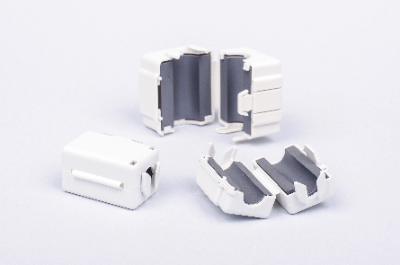What Is a Ferrite?

A Ferrite is a ceramic composed mainly of iron oxide and is used as a magnetic material.
Because it is ceramic, its electrical resistance is higher than that of metallic magnetic materials and is characterized by excellent corrosion and chemical resistance.
Uses of Ferrites
Ferrites are mainly used as a magnet called ferrites magnet. Because it is inexpensive and can be mass-produced, its use fields are diverse, including home appliances, game consoles, and personal computers.
Ferrites are also used as the core of transformers and as a material to block electromagnetic waves in radio wave anechoic boxes and anechoic chambers. Ferrite particles are also used as carriers to carry toner in laser printers, etc. Ferrites are a magnetic material that permeates our daily lives.
Types of Ferrites
There are three types of ferrites as follows.
1. Spinel-Type Ferrites
Spinel-type ferrites are ferrites whose main component is Fe2O4. In the past (because its main component was iron oxide) it had to be heat-treated at a temperature of 800°C or higher to be produced.
In recent years, it has become possible to produce it at temperatures as low as 100°C by conducting the reaction in an alkaline solution. Spinel-type ferrites exhibit soft magnetic properties when mixed with additives such as manganese, cobalt, nickel, copper, and zinc.
2. Hexagonal Ferrites
Hexagonal ferrites are ferrites with the chemical formula M-Fe12O19 (M: Ba, Sr, Pb, etc.). It is hard ferrites that exhibit complex magnetism when barium or strontium is added.
3. Garnet-Type Ferrites
Garnet-type ferrites are ferrites with the same type of crystal structure as natural pomegranate stone and have the chemical formula Mg3Al2Si3O12. Garnet-type ferrites are soft ferrites that exhibit the same mild magnetic properties as spinel-type ferrites.
Other Information on Ferrites
1. Properties of Ferrites
- Hard Ferrites: Hard ferrites have ferromagnetic properties that become magnetic once a strong magnetic field is applied and then remain magnetic.
- Soft Ferrites: Soft ferrites have weak magnetic properties that develop magnetization when a magnetic field is applied and cease to be magnetic when the field is removed. It is characterized by its high magnetic permeability and is used in the cores of coils and transformers.
2. Mechanism of Noise Reduction by Ferrites
Ferrites are also used as a noise-reducing component. For example, EMI (Electromagnetic Interface) is a significant problem in high-speed communication signals such as USB, etc. EMI (Electromagnetic Interference) is not limited to communication lines but refers to unwanted electromagnetic noise emitted by electrical equipment.
In terms of EMI certification and quality assurance, electrical equipment is classified as Class A or Class B, and appropriate EMI countermeasures are required for each product. Usually, EMI countermeasures are taken at the time of circuit and pattern design, but ferrites may be used in the later stages of design and when development time is limited.
By wrapping the ferrites around the noise-generating harness, the impedance of the cable changes according to the magnetization of the ferrites, and as a result, the noise current can be reduced. However, reducing noise current means that high-frequency components are reduced. In other words, the ferrites function as a simple low-pass filter.
Thus, it is essential to keep in mind that reducing high-frequency components leads to signal distortion, which may cause waveform accentuation and, eventually, signal quality degradation. The noise reduction characteristics of ferrites are determined by their impedance, which varies depending on the ferrite’s material, size, and number of turns.
When the ferrite material is the same and when the exact size is used, the impedance generally increases with the number of turns N in the harness. Although the increase in impedance results in more powerful noise suppression, the number of turns should be selected according to the frequency band to be suppressed.
The cross-sectional area also affects the impedance, and as a rule, ferrites with a smaller inner diameter and a larger outer diameter have a higher impedance. A wide range of ferrites are available as high-frequency countermeasure components. It is important to understand the characteristics of each and use ferrites with the appropriate characteristics for the frequency band to be counteracted.